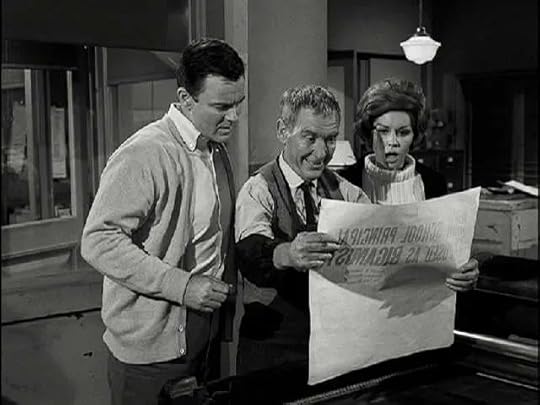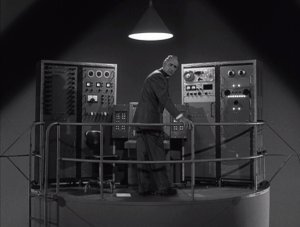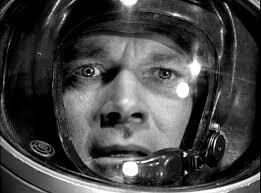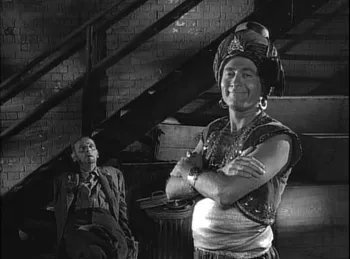October 3, 2024: The Twilight Zone rewatch continues with season 4, episodes 9-12!
Season 5, Episode 8, “Printer’s Devil”
This episode first aired February 28, 1963.
This episode was based on Charles Beaumont’s first published short story, “The Devil, You Say?”.
Imdb on the magical quick-snap flame: “”The special effect of Burgess Meredith creating a flame to light his cigar merely by snapping his fingers was accomplished by having two electric wires attached to a battery running up Meredith’s coat and concealed on his fingers. Meredith held his fingers in a can of ice water until they were numb, and then a crew member put lighter fluid on his fingers. Bringing the wires together created a spark that ignited the fluid so he could light the cigar.” If you look closely, you can see that Meredith’s fingers and part of his hand were covered with a flame retardant gel.
This was the only episode Ralph Serensky directed for the series. He was a Stark Trek veteran who directed such classics as “This Side of Paradise”, “Metamporphosis”, “Obsession”, “Return to Tomorrow, “Bread and Circuses”, “Is There in Truth No Beauty?”, and “The Tholian Web”, the last of which went uncredited.
Burgess Meredith makes his fourth and final Twilight Zone appearance in this episode.
Robert Sterling, who played Douglas Winters, teamed with his then wife, Anne Jeffreys, for the comedy series Topper (1953) which gained them fame on the small screen. He was considered for the role of Perry Mason (1957) but lost out to Raymond Burr.
It would seem that my early concerns about season 4’s lenghtier runtimes have been for naught (for the most part) as I enjoyed this episode as well. Meredith is terrific as always but I found the newspaper setting pretty antiquated and the ending somewhat contrived. Solid, but unlikely to make it into my season 4 Top 5.
Season 5, Episode 10, “No Time Like the Past”
This episode first aired March 7, 1963.
The original title of this episode was “You Must Go Home Again”. In the original story, a soldier from the far future takes a vacation to the past where he settles into a small town and becomes a local hero of sorts. Eventually, one of his fellow soldiers appears and makes a pitch for him to fulfill his duties and return to the future – but the soldier elects to stay put. In retrospect, that would have been a much more effective story.
This episode went through many rewrites and reshoots. Coincidentally (or not), it marked the departure of producer Herbert Hirschman and the arrival of his replacement, Bert Graner.
Originally, the episode opened with a political discourse between the two scientists. It was excised, and I can’t help but feel we dodged a bullet there. Not all of them, but that particular one anyway.
The small town set was previously used in “A Stop at Willoughby”.
“No Time Like the Past” is Serling at his hokiest. And sloppiest. This episode feels like two different episodes stitched together – and, it turns out, it esentially IS given that all of the early scenes of Driscoll going back in time in an attempt to change the past – to no avail – were added after producers viewed the initial rough cut.
What’s particularly galling is that, after the first three failed attempts to change history (one the result of a decision to answer the door for clean towels!) we are told that this proves history cannot be changed. Then Driscoll travels back to the idyllic past and is warned not to change the past because it could have terrible ramifications. But why? Didn’t we already establish the past could not be changed?
This episode felt like absolute nonsense. The moment when Driscoll just happens to remember the fire that struck this inconsequential schoolhouse had me rolling my eyes. Quite the student of history.
If you want to check out a much better written version of this story, see Harlan Ellison’s “City on the Edge of Forever” from the classic Star Trek series. I understand Ellison took issue with the way his original script was adapted but, all the same, it is miles beyond this low energy effort.
Season 4, Episode 11, “The Parallel”
This episode first aired March 14, 1963.
Serling’s trademark “Submitted for your approval…” is only heard in four episodes of the series including this one.
Shortly after the episode aired, the production faced yet another plagiarism lawsuit, this one from a writer who had submitted a story idea in season one titled “Carbon Copy”. The suit was settled for $6,500. In retrospect, Serling surely came to regret his first season decision to accept outside pitches.
In the original script, after spending their first night together following hubby’s return from space, Mr. and Mrs. Gaines realize something is….different. This was considered too risque at the time.
Actor Steve Forrest played the protagonist in this episode whiel his brother, Dana Andrews, played the time-traveling protagonist in the previous episode. No explanation for their different last names.
The house featured in this episode also appeared in “Mute”. and “Stopover in a Quiet Town”.
The consoles that appear in the Capcom communication center also appeared in The Outer Limits and The Man from U.N.C.L.E.
Overall, a fairly middling episode that I thought would have been better served by a shorter runtime. The mere idea of a parallel universe is not enough to sustain this one as Gaines is never in any real danger and, in the end, his situation is more of a major inconvenience than anything else. In the end, the problem is conveniently solved, minus any interesting twist.
Season 4, Episode 12, “I Dream of Genie”
This episode first aired March 21, 1963.
Writer John Furia was approached to write a Twilight Zone script by series producer Herbert Hirschman. According to Furia: “We had worked together before, but I had hesitated. I was not comfortable about approaching the idea in the science fiction format the Twilight Zone had established. I played with the idea of a man who imagines the possibilities – and the consequences – before choosing his one wish. Hirschman liked my proposal so I wrote the teleplay. What pleased me most was not seeing how the film turned out when it was telecast, but Serling quoted the introduction I wrote, almost verbatim.”
Furia would go on to staff on The Waltons, created by fellow TZ writer Earl Hammer Jr.
Actor-turned-director Robert Gist, who directed this episode, also helmed Star Trek’s “The Galileo Seven”.
Howard Morris, who played George P. Hanley, got his start on Sid Caesar’s “Your Show of Shows” but is perhaps best remembered as mountain man Ernest T. Bass from The Andy Griffith Show.
Jack Albertson, t.v.’s Man from Chico and the Man, returns for a second and final Twilight Zone guest spot following his appearance in season 3’s “The Shelter”.
Patricia Barry, who played sexy and sought-after 20-year-old birthday-secretary Ann was actually 40 when this episode was shot.
Sigh. What can I say? Another comedic misfire. Watching these episodes is doubly disappointing because not only are they underwhelming, but they took a slot that could have gone to a sci-fi or horror-themed script. “I Dream of Genie” is just more of what we’ve seen before on the show, less successfully executed over a longer runtime. And that “twist” ending really felt like the writer pulled it out of the very bottom of the idea bin.
The post October 3, 2024: The Twilight Zone rewatch continues with season 4, episodes 9-12! appeared first on Joseph Mallozzi's Weblog.
Joseph Mallozzi's Blog
- Joseph Mallozzi's profile
- 39 followers







